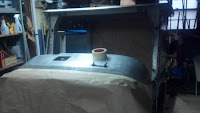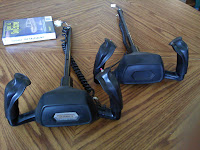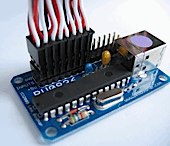
 After re cleaning the metal surface and cutting the simulated leather upholstery fabric (I know, simulated leather for a simulated plane LOL ) to size, I made the cut outs for the defrost vent and the avionics stack cooling vent. I then had to mask off all the surfaces around the dash so I would not cause any problems with over spray when applying the adhesive. With that done I applied an aerosol adhesive to both the metal surface and the back of the upholstery fabric. When it got tacky enough I positioned the material over the vents and then smoothed it out, and pressed it down. It set up in a very short time and I was able to do some final trimming on around the vents and edges. With that done I reinstalled the trim rings around the vents and removed all the masking I had previously done. After that started the prep for the windshield install. The end result came out rather well.
After re cleaning the metal surface and cutting the simulated leather upholstery fabric (I know, simulated leather for a simulated plane LOL ) to size, I made the cut outs for the defrost vent and the avionics stack cooling vent. I then had to mask off all the surfaces around the dash so I would not cause any problems with over spray when applying the adhesive. With that done I applied an aerosol adhesive to both the metal surface and the back of the upholstery fabric. When it got tacky enough I positioned the material over the vents and then smoothed it out, and pressed it down. It set up in a very short time and I was able to do some final trimming on around the vents and edges. With that done I reinstalled the trim rings around the vents and removed all the masking I had previously done. After that started the prep for the windshield install. The end result came out rather well. Even after reading the installers notes, installing the windshield was a far more involved and time consuming process than I thought it would be. While the windshield was made to order to fit the make, model, and year of aircraft it was by design still not an exact fit. The manufacturer explained to me that the sides and bottom edges are intentionally cut slightly oversize to allow for minor variations caused by normal stresses on the airframe. Because of this it is necessary to do a pre install test fit. It's dome without the felt gasket or caulking. With it in place the edges are marked allowing enough additional clearance for the felt gasketing, something I didn't allow enough for on one edge... Then the windshield is removed again and trimmed to size. I used a Dermal with a cutoff wheel to make the cuts.
Even after reading the installers notes, installing the windshield was a far more involved and time consuming process than I thought it would be. While the windshield was made to order to fit the make, model, and year of aircraft it was by design still not an exact fit. The manufacturer explained to me that the sides and bottom edges are intentionally cut slightly oversize to allow for minor variations caused by normal stresses on the airframe. Because of this it is necessary to do a pre install test fit. It's dome without the felt gasket or caulking. With it in place the edges are marked allowing enough additional clearance for the felt gasketing, something I didn't allow enough for on one edge... Then the windshield is removed again and trimmed to size. I used a Dermal with a cutoff wheel to make the cuts.Have you ever seen those "Blend-Tech" YouTube commercials where the guy puts everything from bic lighters to billiard balls into their blender, and grinds them to dust. It's an amazing blender, but I digress. At the end of each one of the videos he says "Bic lighter smoke, Don't breath that!" or Billiard Ball Smoke, Don't Breath That!", etc.. Now after cutting that windshield my strongest advice to anyone who cuts plexi' is "Plexiglas smoke, DON'T BREATH THAT!" I wore a respirator mask which helped keep the dust (and there was a lot of it) out of my lungs. But, it didn't help the huge amount that collected on my clothing and in my hair.
 It worked very well and all these steps took about two hours. After that I adhered the felt gasketing to all the edges and attempted to do the final install. That's where it got real difficult. Despite every blocking and jig arrangement I attempted I could not get the windshield into the upper mounting flange on the fuselage. I had to give in and decide it was a two person job. Thanks to a family member who was able to come over and work with me we were able to come up with a solution. Not an easy one, but the only one that worked. I am again amazed at the difficulty and complexity of the work that Airframe & Power Plant Mechanics do. After that I reinstalled the outside mounting trim and started the tedious but satisfying process of reinstalling the nearly 100 rivets.
It worked very well and all these steps took about two hours. After that I adhered the felt gasketing to all the edges and attempted to do the final install. That's where it got real difficult. Despite every blocking and jig arrangement I attempted I could not get the windshield into the upper mounting flange on the fuselage. I had to give in and decide it was a two person job. Thanks to a family member who was able to come over and work with me we were able to come up with a solution. Not an easy one, but the only one that worked. I am again amazed at the difficulty and complexity of the work that Airframe & Power Plant Mechanics do. After that I reinstalled the outside mounting trim and started the tedious but satisfying process of reinstalling the nearly 100 rivets.And so ended my weekend, or at least the sim pit building portion. The rest of the family got home late Sunday afternoon and we spent time catching up on each others adventures. Mine you know about, there's was a great Girl Scout camping trip.
That's all for now. I'm off to do some more e-bay hunting to find the interior trim parts that mount against the newly installed window and to design the wing root end caps that will follow the forward contour of the windshield and cover where the wings used to mount. More to come when I make more progress....






